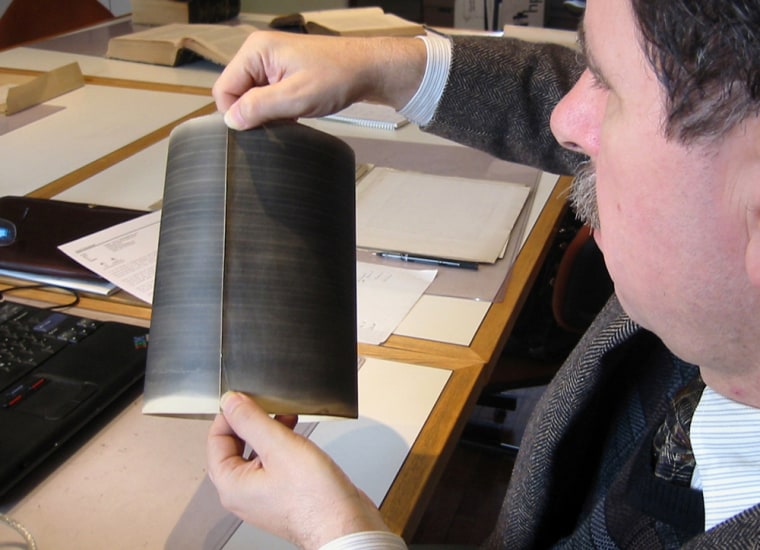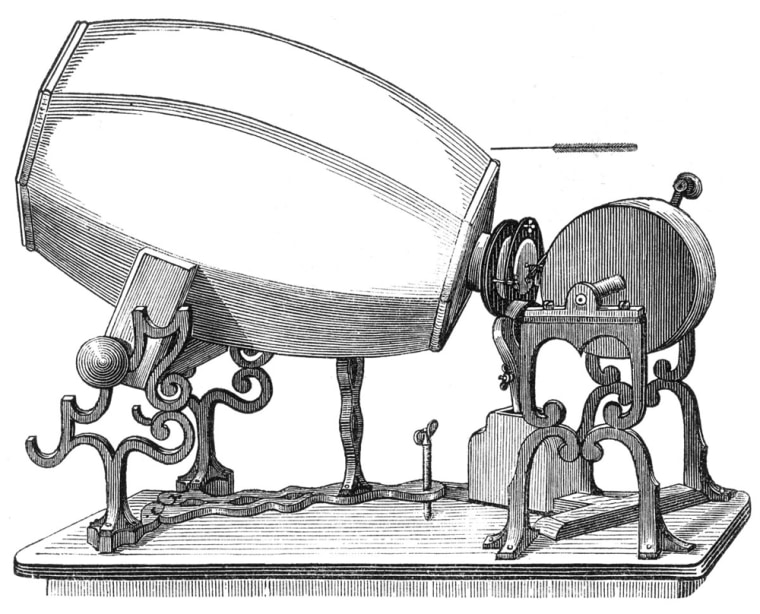At first listen, the grainy high-pitched warble doesn't sound like much, but scientists say the French recording from 1860 is the oldest-known recorded human voice.
The 10-second clip of a woman singing "Au Clair de la Lune," taken from a so-called phonautogram, was recently discovered by audio historian David Giovannoni. The recording predates Thomas Edison's "Mary Had a Little Lamb" — previously credited as the oldest recorded voice — by 17 years.
The tune was captured using a phonautograph, a device created by Parisian inventor Edouard-Leon Scott de Martinville that created visual recordings of sound waves.
Using a needle that moved in response to sound, the phonautograph etched sound waves into paper coated with soot from an oil lamp.
Giovannoni and his research partner, Patrick Feaster, began looking for phonautograms last year and in December discovered two of Scott's — from 1857 and 1859 — in France's patent office. Using high-resolution optical scanning equipment, Giovannoni collected images of the phonautograms that he brought back to the United States.
"What Scott was trying to do in 1861 was establish that he was the first to arrive at this idea," Giovannoni said. "He was depositing with the French Academy examples of his work."
"We took those images back to Lawrence Berkeley National Laboratory and found that (Scott's) technique wasn't very developed," Giovannoni said. "There were squiggles on paper, but it was not recording sound."
So Giovannoni, who collaborates with many other audio historians, including scientists at Berkeley, asked the French Academy of Sciences to send digital scans of more of Scott's papers. Those scans arrived on March 1.
"When I opened up the file, I nearly fell off my chair," Giovannoni said. "We had beautifully recorded and preserved phonautograms, many of which had dates on them."
While Giovannoni was excited by the images, they still needed to be translated into sound.

Creating sound from lines scrawled on sooty paper was a job for Berkeley lab scientists Carl Haber and Earl Cornell. Haber and Cornell had previously created sound from phonautograms that Edison had created in 1878 of trains.
The scientists used optical imaging and a "virtual stylus" to read Scott's sooty paper. They immediately got sound, but because phonautograph was hand-cranked its speed varied and that changed the recording's pitch.
"If someone's singing at middle C and the crank speeds up and slows down, the waves change shape and are shifting," said Cornell. "We had a tuning fork side by side with the recording, so you can correct the sound and speed variations."
On March 3, Haber and Cornell sent audio back to Giovannoni, and another engineer further fine-tuned the recording to bring the voice out more from the static. A person can be heard singing, "Au clair de la lune, Pierrot repondit" ("By the light of the moon, Pierrot replied").
"When I first heard the recording as you hear it ... it was magical, so ethereal," said Giovannoni. "The fact is it's recorded in smoke. The voice is coming out from behind this screen of aural smoke."
Giovannoni said the reconstructed audio pushes back the frontier of recorded sound.
"It's like discovering the world's oldest photograph and learning that the photograph was taken 17 years before the invention of the camera," he said. "In this case, the oldest sound that we can generally hear, up until today, has been from 1888. This predates it by 28 years."
Scott never intended for anyone to listen to his phonautograms, Giovannoni said. "What Scott was trying to do was to write down some sort of image of the sound so that he could study it visually. That was his only intent," he explained.
Nevertheless, the result of his work is being played in public at last on Friday at the annual conference of the Association for Recorded Sound Collections at Stanford University. It is also posted on the Web.
This report includes information from The Associated Press and Reuters.
